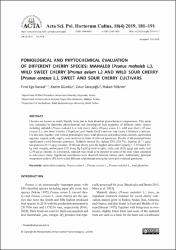| dc.contributor.author | Karaat, Fırat Ege | |
| dc.contributor.author | Gündüz, Kazım | |
| dc.contributor.author | Saraçoǧlu, Onur | |
| dc.contributor.author | Yıldırım, Hakan | |
| dc.date.accessioned | 2021-06-01T12:03:11Z | |
| dc.date.available | 2021-06-01T12:03:11Z | |
| dc.date.issued | 2019 | en_US |
| dc.identifier.citation | Karaat, F. E., Gündüz, K., Saraçoğlu, O., & Yıldırım, H. (July 23, 2019). Pomological and phytochemical evaluation of different cherry species: mahaleb (Prunus mahaleb L.), wild sweet cherry (Prunus avium L.) and wild sour cherry (Prunus cerasus L.), sweet and sour cherry cultivars. Acta Scientiarum Polonorum Hortorum Cultus, 18, 4, 181-191. | en_US |
| dc.identifier.issn | 1644-0692 | en_US |
| dc.identifier.uri | https://doi.org/10.24326/asphc.2019.4.17 | |
| dc.identifier.uri | 2545-1405 | |
| dc.identifier.uri | https://hdl.handle.net/20.500.12899/170 | |
| dc.description.abstract | The aim of this study was to determine the strains of tomato yellow leaf curl virus (TYLCV) on the tomato plants growing intensively in Adana, Mersin and Antalya provinces and also investigate the transmissibility of virus by the vector B. tabaci biotypes in 2015 and 2017. For this purpose, unperiodical field observations were paid in different districts of those provinces. The TYLCV infected tomato plants and whiteflies on these plants were collected from different greenhouses and fields. The 747 samples of tomato infected with TYLCV were tested by PCR techniques. It was determined that the strains TYLCV-Israel, TYLCV-Sicilia, TYLCV-Sardinia and TYLCV-Mild were found to be infected via strain specific primers. PCR study also indicated that the same strains of TYLCV were also found on the whitefly samples collected from the infected tomato plants. DNA analyses by using specific primer Bem 23-F and R in an individual single whitefly, due to clarification of B. tabaci biotypes, has clearly showed that biotype B is a common vector of TYLCV in Turkey. Molecular techniques identified that Israel, Sardinia, Sicilia and Mild strain of TYLCV were present in three tomato cultivation areas in Mediterranean Region. B. tabaci biotype B (formerly B. argentifolii) was detected as a vector of those of strains. It was observed that (%92) B. tabaci Biotype B and (%8) Biotype Q others were responsible for transmission as vector of TYLC respectively. Individual viruliferous Biotype B samples examined in PCR showed that the most determined TYLCV strain as Israel was the most common among the strains, what were identified. | en_US |
| dc.language.iso | en | en_US |
| dc.publisher | Wydawnictwo Akad Rolniczej W Lublinie | en_US |
| dc.relation.ispartof | Acta Scientiarum Polonorum, Hortorum Cultus | en_US |
| dc.rights | info:eu-repo/semantics/openAccess | en_US |
| dc.subject | Antioxidant capacity | en_US |
| dc.subject | Prunus avium L | en_US |
| dc.subject | Prunus cerasus L | en_US |
| dc.subject | Prunus mahaleb L | en_US |
| dc.subject | Total phenolics | en_US |
| dc.title | Pomological and phytochemical evaluation of different cherry species: Mahaleb (prunus mahaleb L.), wild sweet cherry (prunus avium L.) and wild sour cherry (prunus cerasus L.), sweet and sour cherry cultivars | en_US |
| dc.type | Article | en_US |
| dc.authorid | 0000-0002-6473-5909 | en_US |
| dc.authorid | 0000-0003-3480-6013 | en_US |
| dc.department | MTÖ Üniversitesi, Ziraat Fakültesi, Bahçe Bitkileri Bölümü | en_US |
| dc.institutionauthor | Gündüz, Kazım | |
| dc.institutionauthor | Yıldırım, Hakan | |
| dc.identifier.doi | 10.24326/asphc.2019.4.17 | |
| dc.identifier.volume | 18 | en_US |
| dc.identifier.issue | 4 | en_US |
| dc.identifier.startpage | 181 | en_US |
| dc.identifier.endpage | 191 | en_US |
| dc.relation.publicationcategory | Makale - Uluslararası Hakemli Dergi - Kurum Öğretim Elemanı | en_US |
| dc.identifier.scopus | 2-s2.0-85073294411 | en_US |
| dc.identifier.scopusquality | Q3 | en_US |
| dc.identifier.wos | WOS:000502048400017 | en_US |
| dc.identifier.wosquality | Q4 | en_US |
| dc.indekslendigikaynak | Web of Science | en_US |
| dc.indekslendigikaynak | Scopus | en_US |


















